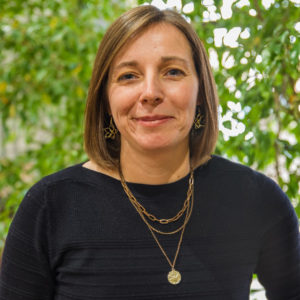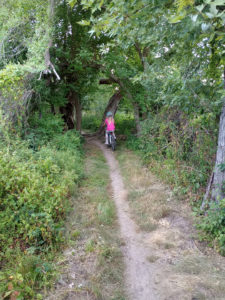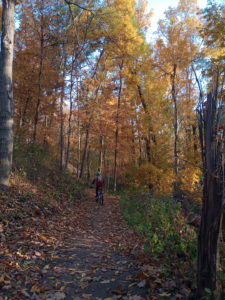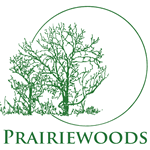 My youngest child learned to ride last summer. I watched her front bike wheel wobble on the loose gravel as she sought to find that elusive balance that only comes with time and tumbles. On our return route, she stopped abruptly and gazed into the shadows and underbrush of a one-track dirt trail. With wild eyes of curiosity, she asked, “Where does this lead?” I understood she didn’t have the control to attempt even a green-level mountain bike one-track trail, but I also saw that look of wonderment and knew she was at the age to create a bond with the land that would last decades. Against better judgment, we embarked on a prolonged journey that day, sideswiping trees and spilling into patches of poison ivy lining the narrow trail that wound through the liminal space between field and river. Upon our return home, as I ferociously scrubbed the poisonous invasive oils off her arms and legs, considering I had most likely ruined any desire to try again, she looked at me with a huge grin and asked, “Does it always feel like this?”
My youngest child learned to ride last summer. I watched her front bike wheel wobble on the loose gravel as she sought to find that elusive balance that only comes with time and tumbles. On our return route, she stopped abruptly and gazed into the shadows and underbrush of a one-track dirt trail. With wild eyes of curiosity, she asked, “Where does this lead?” I understood she didn’t have the control to attempt even a green-level mountain bike one-track trail, but I also saw that look of wonderment and knew she was at the age to create a bond with the land that would last decades. Against better judgment, we embarked on a prolonged journey that day, sideswiping trees and spilling into patches of poison ivy lining the narrow trail that wound through the liminal space between field and river. Upon our return home, as I ferociously scrubbed the poisonous invasive oils off her arms and legs, considering I had most likely ruined any desire to try again, she looked at me with a huge grin and asked, “Does it always feel like this?”
Within weeks, this kid was flying through the woods and prairies, both bike and body scratched and battered, bellowing in her young voice, trying to find a vocabulary yet not formed to describe how she felt on the trail. This marked the summer when she breathed in the Iowa soil, and the land was no longer an object but a companion.
Think of your earliest memory of the land when you felt part of it and not on top of it. I was six. As a child, our Midwest farm became my playground for exploring solo well before I turned double digits. In the days squeezed between pre-tech sovereignty and the grasp of the digital era, like most kids in the ’80s, I experienced unrestrained freedom to roam. My feet led me through deep glens with caves, bubbling streams, and thick timbers sheltering Northeast Iowa’s sacred algific talus slopes. The lay of the land was engrained in my memory by following narrow deer trails that wound through the otherwise impenetrable thickets of multiflora rose. Deep in the ravines, in the mere .5% of the land that Iowa commercial agriculture did not desecrate, stood the century oaks, saved only by terrain too raw to plow. Here, beneath their sprawling limbs, my young self felt a confidence and awe found nowhere else. The soil soaked into my veins, flooding my heart with a sense of wonder and purpose. No matter where my feet led me, I was never lost.
“To those devoid of imagination, a blank place on the map is a useless waste; to others, the most valuable part.”
―Aldo Leopold, A Sand County Almanac and Sketches Here and There
 These are the sacred liminal spaces in Iowa, the parts left over, deemed valueless because the plow could not touch them. They account for a mere 3% of our landscape. While highly degraded, these narrow strips between fields and rivers, steep ravines, and undrained wetlands hold our biodiversity and whisper what Iowa once was and what it can be again.
These are the sacred liminal spaces in Iowa, the parts left over, deemed valueless because the plow could not touch them. They account for a mere 3% of our landscape. While highly degraded, these narrow strips between fields and rivers, steep ravines, and undrained wetlands hold our biodiversity and whisper what Iowa once was and what it can be again.
Iowa is the most altered landscape in the world. 97% of our land is unrecognizable from its pre-white settlement state; 91% has been plowed, tiled, deforested, and grazed to a point that could soon be beyond repair. 6% of our land is sodded and paved. It is the ultimate story of taming and conquering, manipulating without considering the consequences.
Today, our waterways and lakes are grossly impaired. We no longer know to what extent because water quality testing funding has been cut at the state level. Ten years into the Nutrient Reduction Strategy, there is no measurable progress in reducing nitrates. Throughout our agrarian courtship with the land, the Midwest has lost 57 billion metric tons of topsoil through tillage. Iowa’s black fertile soils are rare and viewed as a commodity for today, not for its future nourishment value.
“We abuse land because we see it as a commodity belonging to us. When we see land as a community we belong to, we may begin to use it with love and respect.”
―Aldo Leopold
The story of how we got here is complex, woven through cold-war policy, ingenuity in the form of mechanization, and the idea that prosperity equals excess. A bitter fight rages about who is at fault for our polluted rivers and eroding fields. Is it the politician? Is it the farmer? Is it the consumer? The responsibility rests on all of us. It’s time to pause and, for each of us, ask, what obligation do I have in repairing the land? As a society, we have built a complex system that is now difficult to change: layers of economics and industry devoted to less biodiversity and more homogeneity. We have shifted to believing manicured landscapes of crisp rows, barren of anything else, is the only way. It is a system that has produced affordable, secure food available for the masses, but the costs are documented, and if we don’t pivot, the damage irreparable.
 The world is changing; we note it in our crop planning: frosts well into May, warm spells in February that threaten to force apple trees out of their slumber too early, extended droughts in the summer with record-high temperatures, the ground fissuring beneath our feet desperate for moisture. Climate change is no longer a story of melting ice caps far from view; we are watching it unfold in our home fields.
The world is changing; we note it in our crop planning: frosts well into May, warm spells in February that threaten to force apple trees out of their slumber too early, extended droughts in the summer with record-high temperatures, the ground fissuring beneath our feet desperate for moisture. Climate change is no longer a story of melting ice caps far from view; we are watching it unfold in our home fields.
We have attempted to monetize healing, a carbon credit system so complex few can explain it. Conservation programs work as long as money flows through them to farmers. There is merit to subsidizing conservation practices; it is often the catalyst that allows farmers to better their practices. However, mending will only come once we seek an intimate relationship with the land, and this begins with each of us: farmer, consumer, politician. The first steps to healing are simple. When we find awe in our land, we care for it. There is a renaissance of small farmers in the area, creating farming philosophy and practices to heal the land. These producers focus on growing locally to nourish communities. Their practices invite biodiversity to return to the fields while creating a more resilient and sustainable food system. When producers own the land they farm and hope to hand it down through the generations, they are committed to conserving it. As growers, when we memorize the valleys of a field where the water flows naturally, and the birds nest in the spring, we become aware of a system already operating that we can work alongside. When we can close our eyes and see every foot we plant, learning its characteristics and accepting its faults, we pivot from being an owner to a tender.
Great things come to pass by small and simple means. It is our obligation to take the fragments of land we have access to and build a relationship. We must learn how to be a partner with the land instead of a master. The responsibility lies with all of us to evaluate our relationship and act. Whether you farm or not, your actions are part of the sum. For farmers, take five acres of farmland to diversify and pilot a better practice. Visit the NRCS office and see how you can widen field buffer strips to protect the water. On the urban front, let clover mingle with the manicured grass in the front yard while inviting the pollinators into vibrant albeit unruly beds. As a consumer, consider your budget and buy $100 a week or $10 a week from a local farm; every dollar supports this work. Increase water quality testing by joining the Nitrate Watch Community. As a politician, stand for what is needed and right before it is too late. Change begins with the individual. Small acts turn into flourishing relationships, and mending will commence as we wait for the giant cogs we have built over decades to slow and reverse to adhere to these new practices. May our liminal spaces broaden and become entangled with the fields as we remember how to connect with the land once again. So step outside and go into the nearest woods or field. Remember. Breathe. Connect. Act.
―Emmaly Renshaw
Emmaly Renshaw is the executive director of Feed Iowa First. She is a mother of four and a lover of fields, woods, and everything within. Emmaly resides with her family, rescue beast-dog, and urban bees in Cedar Rapids, Iowa. She looks forward to attending Prairiewoods’ Spirituality in the 21st Century: Hope in Action April 26–27. This year’s event features Susan Bauer-Wu, Rev. Veronica M. Johnson, Leah Rampy and musician Sara Thomsen. Learn more at prairiewoods.org/spirituality-in-the-21st-century.


